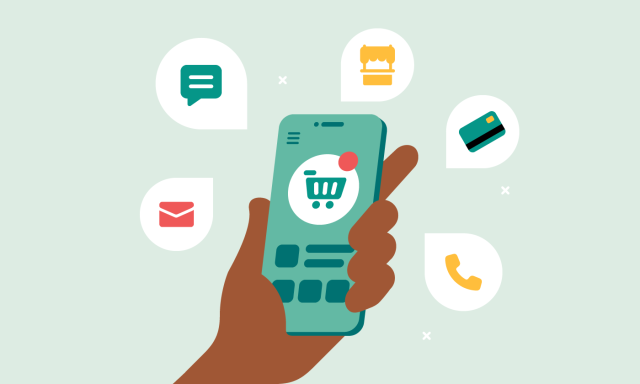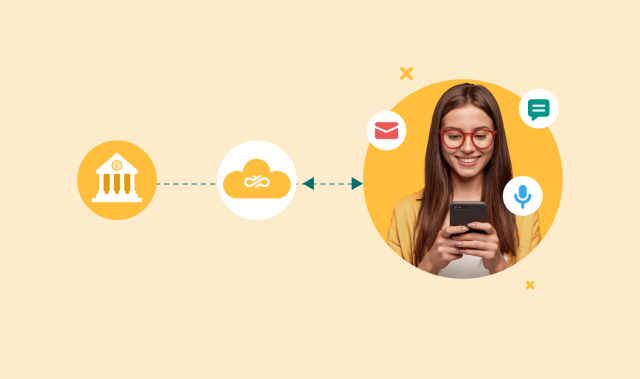Customers engage with your brand across different e-commerce channels every single day. You’re probably used to reaching your customers on social media, in apps, and via email and text campaigns, but these channels might not offer your customers a valuable experience unless they’re connected to each other. Only 3% of customers want their experience to be as automated as possible. The rest are looking for more personalization and interaction — and this is where omnichannel e-commerce shines!
Omnichannel e-commerce is a strategy for seamless shopping that streamlines the experience across channels and links companies to customers in convenient ways. With this level of interconnectivity, brands can personalize and improve the customer experience no matter where customers choose to shop or where they interact with the brand in general.
Customers are looking for rich e-commerce experiences, which makes omnichannel e-commerce a powerful sales approach to boost businesses for the future: E-commerce already makes up more than 20% of all retail spending and is expected to grow to nearly 25% by 2026. Gear up and get ready for an interconnected journey to better serve your customers!
What is omnichannel e-commerce?

Omnichannel e-commerce is an approach to retail that harnesses different channels to meet different customer segments where they are.
If it sounds familiar, that might be because it has the same foundations as omnichannel retail, but sets its sights strictly on the growing e-commerce market. Instead of including a brick-and-mortar presence in the equation, omnichannel e-commerce focuses only on online channels.
Omnichannel vs. multichannel e-commerce

The difference between omnichannel and multichannel e-commerce is that an omnichannel approach creates a consistent and connected experience for customers across channels, while a multichannel approach offers different channels that aren’t connected. Omnichannel gives companies the resources to meet customers where they’re at and offer seamless customer service on any channel.
| Omnichannel | Multichannel | |
|---|---|---|
| Advantages: | Customer-focused, flexible, seamless, and easy to scale | Clear path for communication to reach customers where they are |
| Disadvantages: | Might be unnecessary for brands with customers who only use one channel | Channel-focused and difficult to change communication channels |
While multichannel e-commerce prioritizes the customer’s preferred channel, it doesn’t maintain continuity in the customer’s journey across channels. Omnichannel takes a truly customer-centric approach that prioritizes their experience. This makes omnichannel e-commerce strategies easy to scale as your company grows with your customers.
How omnichannel will benefit your e-commerce business

As e-commerce takes an increasingly larger slice of the retail sales pie, it’s more important than ever for brands to get creative. An omnichannel e-commerce approach can boost traffic and sales, improve data collection, and create a smoother, more consistent experience for customers.
1. Uptick in traffic and sales
By engaging with customers across channels, you instantly increase convenience. If customers don’t have many barriers to accessing the information they need, they might be more likely to go through with a purchase. In fact, 63% of shoppers already insist on researching online before a major purchase — so why not meet them there?
2. Smarter user data collection
When you offer customers several interconnected ways to communicate with your brand, you’re able to draw a more complete picture of their tastes and preferences than you would if they were only using your app or a chatbot on your website. In fact, when it comes to the full customer experience, almost 9 in 10 customers say two-way conversations are important to them. Conversational channels are a great opportunity to create a unique customer experience for everyone who interacts with your brand on some level.
3. Consistent customer experience
Omnichannel e-commerce keeps the conversation going when a customer who reaches out on Instagram ends up on your website browsing products and opts in for email or text alerts. The next day, you can send them an email with a discount code and a link to an item they viewed or added to their cart. This way, you reach customers on their preferred channel and keep things in sync when they hop over to another channel to continue their journey.
4 ways to diversify your online strategy

While omnichannel e-commerce continues to heat up, companies can stay ahead of the curve by developing a dedicated cross-platform strategy. Here’s how.
1. Keep the focus on the customer
An omnichannel e-commerce strategy revolves around customer centricity, which is the capacity to understand the customer, their journey, and their needs, and to place them at the center of all sales-related goals and decisions.
Aim to make the customer journey easy to understand and navigate through, and focus on building trust and prioritizing their needs. Connecting to the baseline reason why your customer actually wants your product is crucial.
- Company doing this well: Luxury fashion house Zadig & Voltaire wanted to create a five-star customer care experience. The brand implemented a message management solution to make its customers feel heard across channels.
2. Use channels that make sense for your brand
It can be tempting to thrust your brand onto the newest social media network in hopes of riding a wave. However, it’ll serve you best to thoroughly evaluate your options and note which communication channels your customers are actually using. Having thousands of followers on TikTok does no good if your target audience still has a landline phone.
- Company doing this well: Its customers wanted to engage via mobile messaging, so AAA (American Automobile Association) overhauled its communication practices with an SMS solution that enabled two-way messaging.
3. Streamline your presence across channels
If your customer can’t be sure that you’re the brand they mean to contact, then your brand won’t be successful in building the trust needed to carry that customer through and make a purchase. Omnichannel means your brand’s presence on different platforms will be consistent and recognizable.
- Company doing this well: To help businesses stand out in a competitive market and build strong relationships with customers across channels, martech solutions company Sureshot added a conversational messaging API to its portfolio. Now it’s easy for Sureshot’s clients to build an omnichannel presence!
4. Personalize, personalize, personalize
We know by now that putting the customer at the center of the experience is the key to any successful omnichannel strategy. The customer isn’t just a generic title, though; each customer is unique, and you should aim to let them know that you understand their unique needs better than your competitors. One way to achieve this is by personalizing your messaging through various channels.
- Company doing this well: The automobile industry has a slow-burn customer life cycle that led to decreased engagement across traditional channels for Nissan Europe. To shake things up, Nissan used a personalized SMS solution that could harness its CRM data to personalize mobile messaging and target its customers anywhere they were.
The future of e-commerce is omnichannel
Ready to diversify your online presence and engage with your customers on the channels that suit them?
Sinch’s solutions let you enable meaningful conversations across all the channels your customers use so you can enrich every step of their purchase journey. Explore our solutions to learn more, or check out our latest consumer research for retail and e-commerce for more insights into what’s driving engagement and growth.
Looking into CPaaS providers? Wondering which vendors are best positioned to support your present and future communications use cases and what you should consider when choosing a CPaaS solution?
Get a copy of the 2023 Gartner® Magic Quadrant™ for Communications Platform as a Service (CPaaS) to find out.




